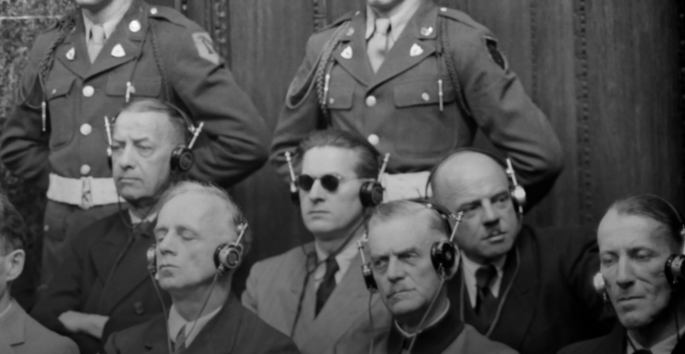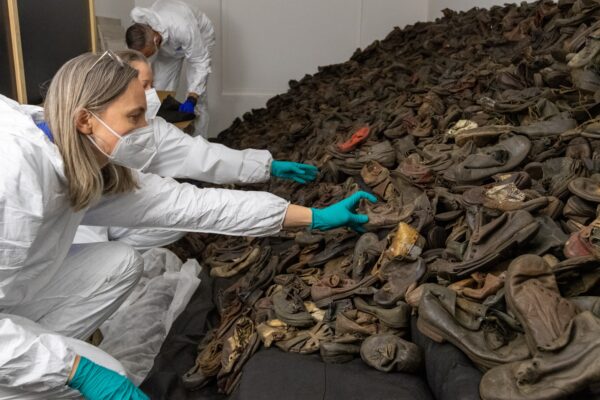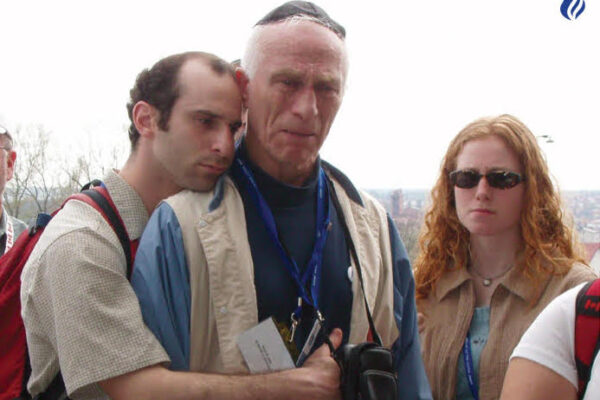Seventy years to the day after the start of the epoch-defining trials, three Jewish advocates stand above the rest: Jacob Robinson, Sir Hersch Lauterpacht, and Raphael Lemkin
Much of what we now understand as the Holocaust—the persecution of the German Jews in the 1930s, the evolution of systematic, European-wide mass murder during the Second World War, the number 6 million, ghettoization, the rampages of the Einsatzgruppen, the death camps in Eastern Europe, the uprising of the Warsaw Ghetto—became part of the proceedings of the Nuremberg Trial of 1945-46 thanks in good measure to three Jewish advocates, none of whom was formally part of the prosecution. Each of them was a lawyer; each was an émigré from an Eastern Europe ravaged by the slaughter of Jewish people during the war, and each, in his own way, drew an important conclusion drawn from the catastrophe that his community of origin had undergone.
The three men are Jacob Robinson of the Institute of Jewish Affairs; Sir Hersch Lauterpacht, the Whewell Professor of International Law at the University of Cambridge, arguably the most distinguished and influential living exponent of that discipline at the time of Nuremberg; and Raphael Lemkin, who had an appointment in the War Crimes Office of the Judge Advocate General’s Office in the Pentagon and hung out on the fringes of the American chief prosecutor Robert Jackson’s very large Nuremberg staff. At Nuremberg, each man offered a different perspective on the Jewish catastrophe. And to an important degree, they stand for three directions that continue to be followed to this day: Robinson was concerned with what he called “the Jewish case,” while Lemkin’s focus was on genocide and Laterpacht’s was on human rights.

Robinson, the eldest of the three, was born in 1889 in the Lithuanian village of Seirijay (pronounced Saray) and studied law at the University of Warsaw. Graduating in 1914, he fought in the Russian campaign against Germany and was captured and imprisoned by the Germans. A Zionist deputy in the Lithuanian parliament and chairman of the Jewish faction there, as well as being a Hebrew educator after the war, Robinson was active in minority affairs and became a legal adviser to the Lithuanian foreign office during the 1930s. An expert on international law, he represented Lithuania at the International Court in The Hague and took an active part in minority issues at the League of Nations. Escaping from Europe via Portugal in 1940, he came to New York with his family and in 1941 helped set up the Institute of Jewish Affairs, an arm of the World Jewish Congress and the American Jewish Congress.
Lauterpacht, certainly the most famous of our three at the time, is considered by many to have been the founder of the modern discipline of international law. A few years younger than Robinson, he was born into an Orthodox Jewish family in the town of Zolkiew, outside Lwów, in Eastern Galicia, in what was then the Austro-Hungarian Empire. He was educated first at the Polish-language university in Lwów and left at the end of the First World War when it came under Polish control and became Jan Kazimierz University. A brilliant student, Lauterpacht completed his doctoral degree in international law in Vienna under Hans Kelsen and then went to England in 1923, finishing a second doctorate at the London School of Economics in 1925. He then embarked on a rapidly successful academic career, teaching first at the LSE, then the University of London, and then was elected to his chair at Cambridge in 1938, at the time the premier such position in the English-speaking world. In 1944 he joined the British War Crimes Executive and became significantly involved in preparing the International Military Tribunal (IMT) that assembled at Nuremberg.
Raphael Lemkin, the youngest of the three, was born in 1900 in the village of Bezwodene, some 250 kilometers northeast of Warsaw in what was then the Russian Empire, later became eastern Poland, and is now in the state of Belarus. From a traditional Jewish environment, he and his family knew of the pogroms in nearby Bialystok and the famous Beilis case of 1911, together with the violent anti-Jewish outbreaks at the end of the First World War. Studying philosophy in Lwów, at Lauterpacht’s university, he went on to take a degree in law at the University of Warsaw and to practice his profession there. Focusing on international law he became active in European minorities issues while remaining loosely involved in Polish academic life. Lightly wounded in the campaign of 1939 against the German invaders, he escaped to Kaunas, in Lithuania, traveled to Vladivostok, and eventually reached the United States via Japan. With a temporary berth at Duke University, in North Carolina, he joined the staff of the Board of Economic Warfare in Washington in June 1942.
All three men, I should add, shared a Yiddish-speaking, traditional East European Jewish background; all three were profoundly touched by the Holocaust with many of the murdered among those whom they had left behind. In the case of Robinson his birthplace, Seirijay, a shtetl community in southern Lithuania where 1,800 Jews lived in 1914, suffered a particularly horrifying fate: The entire population—men, women and children—was shot on Sept. 10 and 11, 1941. According to one author, “229 men, 384 women and 340 children, altogether 1953 people, are buried in the mass graves about three kilometers from the town.” Lauterpacht, for his part, lost his parents, brother, sister, and their children—his entire family, except for one niece, murdered in the Generalgouvernement of Poland. At least one commentator, Professor Brian Simpson, links Lauterpacht’s turning to the unfashionable topic of human rights to this personal catastrophe and that of his people. Lemkin, according to his own account, eventually learned details about 49 members of his own family who perished in the Holocaust: Some of the information about the catastrophe reached him only at the time of the Nuremberg Trial, when he finally met his brother who had survived the massacres.
***
Since the establishment of the Institute for Jewish Affairs, Robinson and his team had labored to make the make the point that the massacre of European Jewry was a unique and distinct crime. “We have been working in this field for four and a half years,” he wrote to Jackson in June 1945, staking out not only his expertise on the matter but also his claim for the prominence of this atrocity in the trial that was being planned for Nuremberg. Close study of World Jewish Congress archive materials by Professor Mark Lewis sheds important light on Robinson’s tactical goals—in particular disagreement within the Institute on whether prewar anti-Semitism was intended to unify the Nazi regime or to help clear the way for military aggression. But in more general terms, Robinson and the World Jewish Congress more than anything else wanted recognition of the Germans’ crimes against the Jewish people as a whole. “The crimes committed against the Jews,” as Robinson explained to the Institute’s staff in December 1944, “were … one collective crime directed against a people—a crime [that] started when Hitler took power.”
At the heart of Robinson’s and the World Jewish Congress’ case was the notion of a grievously victimized Jewish collectivity—a new idea for many in 1945-46. “The ultimate goal of Nazi-German policies with regard to the Jewish people was nothing short of complete physical annihilation,” he noted in a report—an understanding that is commonly accepted today, but that was little understood or appreciated at the time. Robinson was powerfully concerned with documenting this perspective and he felt considerable satisfaction at the way in which this material was ultimately used at the trial. As he put it much later: “The evidence submitted to the [International Military Tribunal] in the Jewish case was overwhelming: More than eight hundred Nazi self-accusing documents … were presented and thirty-three witnesses were heard in addition to all defendants present.” A careful analysis of this documentation leads inexorably to the conclusion of the existence of a conspiracy to destroy the Jewish people and its ruthless implementation, resulting in the death of some 6 million Jews, which constituted 75 percent of the Jewish population in Europe.
Lauterpacht too was heavily preoccupied with what we have come to term the Holocaust, although he hardly ever referred to it in his writings or his scholarship. Known for his restraint and academic formalism, he steered clear of public discourse on the Nazis’ anti-Jewish program—doubtless aware that his words could be taken, in the British legal establishment in which he moved, as a mark of unwarranted partisanship. Still, he shared Robinson’s sense of the Nazis’ distinct crimes against the Jewish people.
In the lead up to the Nuremberg Trial, Lauterpacht ardently urged the British authorities to pursue Nazi war criminals when the war was over, and he tried, unsuccessfully, to persuade the London-based United Nations War Crimes Commission to establish a special unit to look into anti-Jewish crimes. But he had a much wider perspective on which he had built his professional standing: In this the starting point was his promotion of natural law as the source of international legal norms, his critique of state sovereignty, and his championship of the notion of an international rule of law.
In addition to his articulate and learned case for the need to prosecute war crimes and to establish individual criminal responsibility, summed up in an influential article he published in 1944, Lauterpacht’s distinct contribution to the Nuremberg Trial, written into Article 6 of the IMT, is now widely recognized to have been helping to formulate the notion of a tripartite definition of Nazi criminality (crimes against peace, war crimes, and crimes against humanity) and in particular the idea of the latter—clearly one of the major legal innovations of the trial. “Crimes against humanity”—later referred to by Jackson as having been suggested by an “eminent scholar of international law” now acknowledged to have been Lauterpacht—derived from the Americans’ concern, at the London planning conference that assembled in the summer of 1945 to plan the trial, about capturing Nazi crimes that, while associated with the war, were committed both before the outbreak of the conflict in 1939 and also were perpetrated against victims in the Germans’ own population. Lauterpacht, I should add, also played an important role in the drafting of the speeches for his friend the first British chief prosecutor Sir David Maxwell-Fyfe and then, when the Conservatives were replaced by Labour, his successor the new attorney general Sir Hartley Shawcross—who interestingly became a stout opponent of Raphael Lemkin’s drive for a genocide convention in the wake of the Nuremberg Trial.
Genocide, in Lemkin’s historic conceptualization, was a universal plague, not derivative merely from the destruction of European Jews. Lemkin read his “discovery” back to a report on an international legal conference in Madrid of 1933. As Anson Rabinbach points out, this “set forth a narrative in which the concept of ‘genocide’ antedated and anticipated the murder of European Jewry. By locating the origin of the concept in the decade prior to the Holocaust Lemkin could and often did disassociate the origin of the term from his personal experiences as a Jew and a Pole, situating it in the pre-Nazi (or early) Nazi era.” Nevertheless, it was Nazi wartime crimes against civilian populations, and in particular what we now term the Holocaust, that gave his ideas widespread public standing.
Lemkin achieved significant public recognition through his introduction of the term genocide, which he popularized in his book Axis Rule in Occupied Europe, published in late 1944. Based on a careful study of German occupation regimes, Lemkin’s work was widely publicized and discussed in the lead-up to Nuremberg. Prominent reviews, together with editorials in the New York Times andWashington Post became calling cards for his case for the identification and punishment of the crime of genocide. And Lemkin was not afraid to go to the top. Immediately upon the Robert Jackson’s being named American chief prosecutor by President Harry Truman, Lemkin made contact with him and set out on a path that would take him to Nuremberg.
Mainly through his own initiative as a tireless campaigner, Lemkin had some impact on the preparation of the trial both through his book’s treatment of Nazi organizational responsibility and through its comprehensive presentation of the Germans’ attack on “racial minorities and subjugated populations.” Preparing for a major trial just as Lemkin’s book was appearing, War Department official Col. Murray Bernays received an advance copy from David “Mickey” Marcus, an American military officer and legendary war hero involved in occupation planning at the end of the war. In the spring of 1945, when drafting details of a trial was well under way, Lemkin’s work fit neatly into the detailed conceptualization. Jackson, says his biographer Professor John Barrett, even added the word genocide—in his own hand—in a planning memorandum prepared at a meeting in Washington in May 1945.
The very opposite of a team player, Lemkin found himself on the outer edges of Jackson’s staff—“largely unsupervised,” as Barrett shrewdly notes, respected (at least by some) for his expertise, but hardly involved in day-to-day planning or discussion and increasingly bothersome as he buttonholed this one or that one to pay more attention to and to utilize his term, genocide. Lemkin was obviously gratified when the indictment of the accused at Nuremberg referred to genocide in its specification of their crimes: “[The accused] conducted deliberate and systematic genocide, viz. the extermination of racial and national groups, against the civilian populations of certain occupied territories in order to destroy particular races and classes of people and national, racial, or religious groups, particularly Jews, Poles, and Gypsies and others.” It should be noted that these acts were included under War Crimes, and not Crimes against Humanity—a reflection of the way in which these charges were understood at the time.
Robinson was unimpressed. Exasperated rather than elated, he implied to some notables from the World Jewish Congress in a confidential briefing in December 1945 that Lemkin was some sort of unwelcome interloper in the discussions: “Suddenly the idea of Genocide [Lemkin’s term] came into being, and the term was inserted into the document but was not developed. As an example of the application of the concept of ‘Genocide’ ‘Jews and Gypsies’ were cited. When I saw that I got mad, because it so reeked of the Nazi method of humiliation of Jews by putting them in a class with the gypsies. It is a doubtful source of satisfaction that the word, ‘Poles,’ was inserted to make the phrase read: ‘Jews, Poles, and Gypsies.’”
Already in the latter part of 1946 Lemkin was absorbed by the prospect of the genocide convention and the need for its subsequent ratification. Before the end of the trial Lemkin became completely absorbed by his project for the acceptance of the crime of genocide—traveling to conferences in Cambridge (where Lauterpacht was a prominent attendee), to Paris, and to Lake Success, New York, for a meeting of the General Assembly of the United Nations. For Lemkin, everything became secondary to this campaign. Those who caught a glimpse of him at Nuremberg saw him as a driven man. The young American soldier/attorney, Benjamin Ferencz, later a prosecutor himself, described Lemkin as a “nudnik”—a person whose dogged persistence on a matter turns him into a pest. Another American prosecutor, Henry T. King, Jr., who thought he was a “crank,” remembered running into him at the Grand Hotel: “At that time he was unshaven, his clothing in tatters, and he looked disheveled. … Lemkin was very upset. He was concerned that the decision of the International Military Tribunal … did not go far enough in dealing with genocidal actions.” More appreciatingly after the passage of time, William Korey described him as “a one-person non-governmental organization to change the landscape of international law.”
***
There is no indication the three men ever discussed this issue or even overlapped at the Nuremberg proceedings they each attended. It is difficult to imagine them sitting down together, let alone resolving their differences. Yet, moved by the Jewish catastrophe, our three émigrés drew both common and divergent perspectives from the terrible news. To start with the obvious, all three could not help but responding as Jews; all three were deeply imprinted by their Jewish origins in Eastern Europe. All three had been involved in Zionist politics as youngsters—and Robinson, whose affiliation lasted the longest of the three, even represented the Zionists in the Lithuanian parliament from 1922 to 1926. By the time of Nuremberg Lauterpacht had only the most tenuous outward links to Jewish identity of the three—but there is no doubt that his early ties had been substantial. I note that, when he lectured at the Hebrew University of Jerusalem in 1950, on the occasion of the 25th anniversary of the institution’s founding, he gave two lectures, one in English and one in Hebrew, a language that he had learned as a child.
All three men came from polyglot regions of East Central Europe with turbulent and complex histories that were interwoven with potentially explosive issues of national, religious, and ethnic identities. Each of them grew up in a milieu that fostered a cosmopolitan outlook, one that was familiar with many languages, nationalities and cultures. All three had immediate, personal experience of the dreadful war that impacted their region so catastrophically and whose aftershocks continued beyond the “settlement” in Paris of 1918—no settlement at all for their region and their people. All three adopted international perspectives and sought legal solutions to the world’s continuing problems. All three were supporters of the League of Nations system, especially its effort to protect minorities through the League’s minorities treaty regime.
Like so many Jews attracted by a secular education and engagement with the non-Jewish world, all three were drawn to the law, believing that law provided answers to questions about how to order a world in which conflict constantly threatened but opportunity also beckoned. In particular, all three were legal internationalists in the sense that they looked beyond national sovereignty for the ordering of international affairs, part of a general movement among interwar international lawyers, and Jewish international lawyers in particular, to oppose the vesting of all legal authority in nation states. All three, I believe, shared what the legal scholar Martti Koskenniemi refers to as “the sensibility of a generation of lawyers who had grown up in the shadow of the First World War and [who] sought to make international law and organization the instruments of a global federalism within which peace, the rule of law and individual rights could be safeguarded.” All three, in some sense, hearkened to what Koskienniemi calls the Victorian tradition in international law: Anxious when great forces threatened, they “looked back to the middle of the nineteenth century, hoping to resuscitate its liberal rationalism and its ideal of the rule of law, its belief in progress, its certainty about the sense and direction of history.”
Hersch Lauterpacht was the great theorist of this kind of legal project by the second half of the 1930s. Robinson was perhaps the least explicit of our émigrés on this point, but he was a co-author, along with four others, of a 1943 book titledWere the Minorities Treaties a Failure? which saw the League of Nations minorities regime as a flawed and uncompleted, but remarkably progressive effort to redress grievances and build an international structure of peace. The youngest of the three, Lemkin apparently became disillusioned even before the war with how the minorities treaties functioned, sought a more muscular international order, and according to his biographer he worked out a plan to criminalize concerted attacks upon helpless and peaceful groups. In sum, all three shared what has been deemed “liberal cosmopolitanism,” a perspective so widely shared among Jews from in the interwar period, “for whom the only safe place was in the kingdom of the law.”
Yet one should not understate the ways in which the divergent views on Nuremberg flowed from fundamentally different conclusions our émigrés drew from the Jewish catastrophe. Each of them was conscious of what they perceived as the trial’s legal shortcomings, deficiencies that spoke, in their minds, to matters of fundamental concern. While generally happy with the place of the Holocaust at Nuremberg, Robinson especially regretted the limitations that the Tribunal put on crimes against humanity—notably that these were tied to war making and war crimes. While understandably gratified at the presentation of evidence on the destruction of European Jewry, he lamented that Nuremberg had failed to consider this great crime “as a unit in fact and in law”—or, put otherwise, that “the Jewish case was not singled out as a specific crime but was drowned in the abstractions of Articles 6(b) and 6(c) of the Charter.”
Differing from Robinson, Lemkin articulated German criminality as involving the destruction of all kinds of groups and not just Jews. Even with respect to Nazi crimes, he commonly referred to twelve million murdered and seven million torn loose from their homes and enslaved—numbers that encompassed other groups besides Jews, for whom the number 6 million was established and validated by Nuremberg. In a bold leap to a might-have-been, Lemkin apparently persuaded himself that, had only the Fifth International Conference for the Unification of Penal Law held in Madrid in 1930 accepted his proposals, the accused at Nuremberg would have been convicted of crimes against humanity committed before the outbreak of war in 1939. Lemkin remained deeply unhappy that the Nuremberg judges did not see things his way and did not enshrine his termgenocide in their judgment. He lamented that Nuremberg did not tell the world that “a national, racial, or religious group as an entity has the right to exist” and later referred to the day in which the judgment was read as “the blackest day of my life.”
Lauterpacht turned out to be the one with the wind at his back—although it remains to be seen what the ultimate impact will be of the conclusion he drew from Nuremberg. For him, crimes against humanity were to be understood in a quite different sense than that of the strategists who drafted the Nuremberg Charter at the London Conference. Far from an afterthought included to capture some unfortunately neglected dimensions of Nazi criminality, these crimes were to be understood as violations of the very structure of individual human rights: “To lay down that crimes against humanity are punishable is … to assert the existence of rights of man grounded in a law superior to the law of the State. Thus, upon analysis, the enactment of crimes against humanity in an international instrument signifies the acknowledgment of fundamental rights of the individual recognized by international law.” A “major purpose of the war,” he wrote in 1944, had been the creation of an effective instrument for the protection of human rights. That year, with the material support of the liberal, internationally minded American Jewish Committee, he completed his important book An International Bill of the Rights of Man, which appeared in 1945, to be followed by International Law and Human Rights five years later. Together these works had an impact on theUniversal Declaration of Human Rights of 1948 and the European Convention on Human Rights in 1950.
Looking forward, Lauterpacht stood out among his peers as the most important academic promoter of the idea that the individual human being should be the subject of international law, with rights and duties rooted in the law of nations. According to Brian Simpson, Lauterpacht was “the only international lawyer of repute who had devoted serious attention to the idea of an international Bill of Rights, and [who had] published on this subject.” In making this case, he identified Nuremberg as a defining moment for the cause of human rights. This point is well illustrated—and significantly so because of the venue—at his Hebrew University lecture mentioned above. The cause of international law, he argued on that occasion, “the discipline of the rule of law among nations,” was tied up with developments at the end of the Second World War, in which Nuremberg was a major landmark. Of these developments, the most important, which Lauterpacht referred to as the “Nuremberg principles,” were threefold:
1) that the enforcement of international law must cover not only war crimes but also the crime of war itself
2) that international law is concerned not only with the actions of sovereign states but also with the conduct of individuals
3) the enactment, in the Nuremberg Charter, that offenses against humanity constitute an international crime and are subject to the jurisdiction of an international tribunal. It thus laid down the law that there are fundamental human rights superior to the law of the state and that their violation is a crime even if committed in obedience to the law of the land.
Following Nuremberg, Lauterpacht’s emphasis was neither the Jews nor groups but rather individual human rights—for which he sought protections internationally through new institutional structures. Promoting the cause of international human rights he worked as a consultant for the American Jewish Committee, notably joining a delegation to Paris in 1946 seeking to strengthen human rights provisions in postwar treaties and addressing the needs of the victims of Nazi persecution. In particular, Lauterpacht insisted on the fundamental importance of crimes against humanity, helping to transform the significance of those crimes into their present-day meaning as one of the most heinous kinds of criminal behavior. Reticent as always on Jewish issues, he had practically nothing to say explicitly about the Holocaust. But there seems no doubt about the link in his own mind between the murder of European Jews and his human rights project.
The encounter of our émigrés with Nuremberg suggests that all three were profoundly affected by the destruction of European Jews even as they took quite different paths, each touching in some way on questions of rights that should be internationally guaranteed. Their common starting point, I argue, was their experience with the minorities regime of the League of Nations. It could not have been clearer, from the terrible events of the war, that something had gone quite wrong with this system. And the problem was not only Hitler. It was also the whole idea of attempting to fortify the rights of Jews and others by considering them “minorities” that must ultimately rely on international guarantees. “By 1945,” as historian Mark Mazower puts it, “many Jews, if they had not turned to Zionism, felt that being singled out as a minority was itself inviting trouble: better to stand—as they had done in the nineteenth century—on their rights as individuals.” In any event, as Jacob Robinson pointed out, “the problem of minorities in Europe was solved not by the protection of the League but largely by spontaneous or enforced repatriation, by mass expulsions, and by mass murder.”
Robinson’s, Lauterpacht’s, and Lemkin’s work at Nuremberg may be understood as three different efforts to contend with the inadequacies of the interwar mechanisms for minorities protection on which all three had worked and that all three had supported in one way or the other during an early part of their careers. Robinson’s answer was to tie Jewish fortunes to the story of the Jewish catastrophe, seemingly in a belief that the moral effect of knowledge of the Holocaust, energetically promoted by the United States, would help achieve justice for a people sorely wronged. Less bound to specifically Jewish perspectives, Lauterpacht and Lemkin looked to the trial for new structures of international law. Consistent with his longstanding critique of national sovereignty, Lauterpacht’s great cause was international human rights, defining their juridical and institutional platforms and seeking a way forward for their acceptance internationally. For him, Nuremberg’s insistence on the accountability of German war criminals was an important step on a path to achieving this goal. And Lemkin, for his part, saw in the cause of genocide the most fitting response to the global catastrophe. Consumed, not to say obsessed by his project, he failed to appreciate much of what the trial had accomplished. Human rights were well and good, he thought, but as he protested a decade after Nuremberg, they “are concerned with different levels of existence, while genocide deals with nonexistence.” Notwithstanding these differences, each of the émigrés would have agreed that the postwar world order had to address, as a matter of priority, the most vulnerable.
Michael R. Marrus is the Chancellor Rose and Ray Wolfe Professor Emeritus of Holocaust Studies at the University of Toronto. His latest book, Lessons of the Holocaust, will appear in December 2015.
Original article published HERE.









